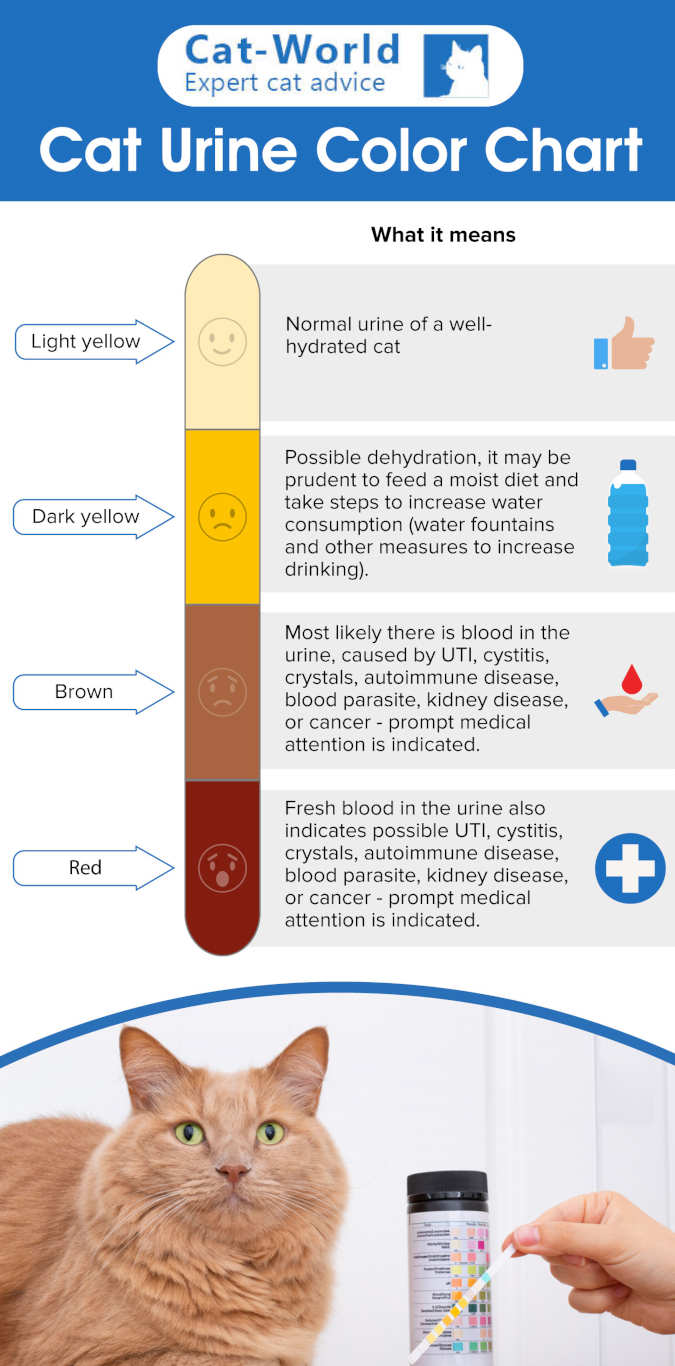In this article, we will explain why cat urine generally smells bad, what color cat urine should be (including a cat urine color chart), and answer frequently asked questions with Dr. Jamie Whittenburg, director of Kingsgate Animal Hospital in Texas, and our veterinarian lead here at Cat World.
What is urine?
Urine is a fluid that contains water and waste products that are secreted by the kidneys. The urine is stored in the bladder until it is voided (discharged) via the urethra. The purpose of urine production is to eliminate excess water and water-soluble wastes from the body.
The urinary system consists of the upper urinary tract, containing the kidneys and ureters, and the lower urinary tract, containing the bladder and urethra.
Why does cat urine smell so bad?
There are several reasons why cat urine smells unpleasant. First, cats evolved as desert-dwelling animals and their body needed to be able to survive on small amounts of water, and as a result of this, a cat’s urine is much more concentrated than that of humans. The more concentrated the urine, the stronger the odor.
Adult cats’ urine contains a sulfur-containing amino acid known as felinine. Males and females excrete this chemical, however, males excrete more, especially intact males. Felinine is odorless until bacteria begin to break it down, at which time it produces its characteristic pungent smell. It is believed that felinine is a precursor to pheromones which serve to attract members of the opposite sex and to mark the cat’s territory.
Interestingly, rats and mice are repelled by the smell of cat urine. However, rats infected with toxoplasmosis become attracted to the smell. This, of course, makes them more vulnerable to predation by cats, helping the parasite to spread to its natural host (the cat).
Food and medication can also have an impact on the smell of cat urine.
Cat urine abnormalities to look out for
If your cat’s urine suddenly has a stronger or different smell, it could be a sign that they have a urinary issue. Other signs may be seen, such as:
- urinating frequently,
- urinating outside of the litter box, and
- straining to urinate.
Other urinary issues may result in dark or bloody urine. If a cat cannot urinate, it is a life-threatening emergency and they must be seen by a veterinarian immediately.
Symptoms of urinary tract infections
Urinary tract infections (UTI) in cats are somewhat rare, though they do occur. Female cats are more likely to be affected. In general, other issues, like idiopathic cystitis, are much more common though both issues share similar clinical signs.
Things to watch for if you suspect a urinary tract infection include:
- frequent urination,
- odorous urine,
- straining to urinate,
- blood in urine, and
- urinating outside of the litter box.
Some cats may exhibit multiple signs while others may not exhibit any signs until they are very ill. Because cats tend to hide their illnesses, it is imperative to pay close attention to changes in your cat’s urinary behaviors.
Cat urine color chart: what color should cat urine be?
Keep an eye on your cat’s litter box because the urine (and feces) can help you to spot potential problems. For example, pink/red urine is a sign of blood in the urine (hematuria).
Cat urine should be a similar color to human urine which is a clear, amber/yellow color in healthy individuals. However as a cat’s urine tends to be more concentrated, you may notice it is slightly darker in color than human urine. Check out the color chart below to understand what your cat urine should look like, and what different colors may mean (This color chart is also available to download as a PDF: cat urine color chart – PDF):

Urine should also be clear, as cloudiness may suggest an infection or other issue in the urinary tract. While fresh cat urine has a distinct smell that is generally unpleasant to people, any foul odors are not normal. Any of the above symptoms should warrant further investigation with a veterinarian.
Urinalysis (UA) is a test performed on the urine to check for a number of diseases such as diabetes, infection, and kidney disease.
Cat urine color chart – table:
| Urine Color | What it means |
| Light yellow | Normal urine of a well-hydrated cat |
| Dark yellow | Possible dehydration, it may be prudent to feed a moist diet and take steps to increase water consumption, these include water fountains and other measures to increase drinking |
| Brown | Most likely there is blood in the urine – caused by UTI, cystitis, crystals, autoimmune disease, blood parasite, kidney disease, or cancer – prompt medical attention is indicated |
| Red | Fresh blood in the urine – indicates possible UTI, cystitis, crystals, autoimmune disease, blood parasite, kidney disease, or cancer – prompt medical attention is indicated |
How to clean cat urine
In order to successfully remove urine, you need to use an enzymatic cleaner to break it down. Common household products and detergents may temporarily mask the odor, but they will not remove it.
- Blot up as much urine as you can with paper towels.
- Sponge the stain with warm water to dilute it as much as possible.
- Continue to remove as much moisture as possible with paper towels.
- Use an enzymatic cleaner, following the manufacturer’s instructions.
For more information on cleaning cat urine, read our article: Cleaning Cat Urine: Step by Step Instructions.
How many times a day does a cat urinate?
This is a tricky question to answer as cats can be very private. The type of food your cat consumes may also make a difference to urine output. Wet food has a higher water content than dry food and may result in a larger volume of urine. This is a good thing and cats should be encouraged to consume as much moisture as possible.
If you notice a change in the frequency of your cat’s urination, whether less or more frequent, the cat should be taken to their veterinarian right away. Urethral blockages in males are very common and are also quickly life-threatening. Other medical problems that cause urinary dysfunction include urinary tract infections, cystitis, bladder stones, kidney disease, autoimmune disorders, cancer, and urinary crystals.
Frequently asked questions
What does it mean if my cat urinates outside the litterbox?
Unfortunately, there are many things that may cause a cat to urinate outside of the litter box and because cats cannot talk to us, it can be both difficult and frustrating. Cats urinating outside of the litter box is one of the top reasons that owners relinquish ownership of their cats.
There are medical conditions that can lead to this behavior and the first step is to take your cat to their veterinarian for a thorough examination and diagnostic workup. This should include bloodwork, x-rays, and urinalysis at a minimum. If all medical causes are ruled out, the issue may be behavioral. Cats with behavioral inappropriate elimination may be responding to stress and anxiety, or dislike of their litter box (location, litter type, dirty box, shape and size of the box, etc.). It is essential to work with a cat-friendly veterinarian and to have patience when dealing with this issue.
My cat’s pee is more pungent than usual – what should I do?
If you notice a sudden change in your cat’s urine smell, it is time for a check-up with their veterinarian. The stronger odor may be due to a food change or mild dehydration, but could also be an early warning sign of something more serious.
What does it mean when my cat has blood in urine?
Blood in a cat’s urine can have many different causes including urinary tract infections, kidney disease, autoimmune disorders, blood parasites, cancer, cystitis, and crystals. An exam and diagnostics including blood tests, urinalysis, x-rays, and ultrasound will be needed to determine the cause.
Is male cat pee the same color as female cat pee?
Yes, both female and male healthy cats produce yellow-colored, clear urine.

